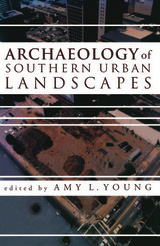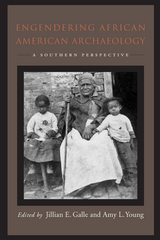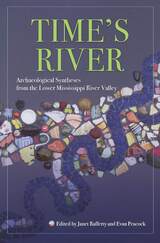
The rapid growth and development of urban areas in the South have resulted in an increase in the number of urban archaeology projects required by federal and state agencies. These projects provide opportunities not only to investigate marginal areas between the town and countryside but also to recover information long buried beneath the earliest urban structures. Such projects have also created a need for a one-volume update on archaeology as it is practiced in the urban areas of the southeastern United States.
Archaeology of Southern Urban Landscapes will assist practitioners and scholars in the burgeoning fields of urban and landscape archaeology by treating the South as a distinctive social, geographic, and material entity and by focusing on the urban South rather than the stereotypical South of rural plantations. The case studies in this volume span the entire southeastern United States, from Annapolis to New Orleans and from colonial times to the 19th century. The authors address questions involving the function of cities, interregional diversity, the evolution of the urban landscape, and the impact of the urban landscape on southern culture. By identifying the relationship between southern culture and the South's urban landscapes, this book will help us understand the built landscape of the past and predict future growth in the region.

“A welcome publication, this book will nicely supplement the other books that are now appearing in the field of African American archaeology.”
—Charles E. Orser Jr., Illinois State University
Over the last decade, the field of American historical archaeology has seen enormous growth in the study of people of African descent. This edited volume is the first dedicated solely to archaeology and the construction of gender in an African American context. The common thread running through this collection is not a shared definition of gender or an agreed-upon feminist approach, but rather a regional thread, a commitment to understanding ethnicity and gender within the social, political, and ideological structures of the eighteenth- and nineteenth-century American South.
Taken together, these essays represent a departure in historical archaeology, an important foray into the study of the construction of gender within various African American communities that is based in the archaeological record. Those interested in historical archaeology, history, women’s studies and African American studies will find this a valuable addition to the literature. Topics range from gendered residential and consumption patterns in colonial Virginia and the construction of identity in Middle Tennessee to midwifery practices in postbellum Louisiana. Contributors to this volume include Melanie Cabak, Marie Danforth, Garrett Fesler, Jillian Galle, Barbara Heath, Larry McKee, Patricia Samford, Elizabeth Scott, Brian Thomas, Larissa Thomas, Laura Wilkie, Kristin Wilson, and Amy Young.
Jillian E. Galle is project manager of the Digital Archaeological Archive of Chesapeake Slavery at Monticello. Amy L. Young is assistant professor at the University of Southern Mississippi.

James Feathers, Gayle J. Fritz, Michael L. Galaty, S. Homes Hogue, H. Edwin Jackson, Jay K. Johnson, Carl P. Lipo, Hector Neff, Evan Peacock, Janet Rafferty, James H. Turner, John R. Underwood, Amy L. Young
READERS
Browse our collection.
PUBLISHERS
See BiblioVault's publisher services.
STUDENT SERVICES
Files for college accessibility offices.
UChicago Accessibility Resources
home | accessibility | search | about | contact us
BiblioVault ® 2001 - 2024
The University of Chicago Press









